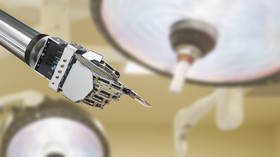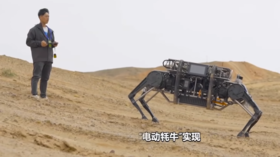Robot performs keyhole surgery on pigs for 1st time

The Smart Tissue Autonomous Robot (STAR) has successfully performed keyhole laparoscopic surgery on four pigs, connecting two ends of an intestine, for the first time ever.
Researchers at Johns Hopkins University said the machine conducted surgery mostly autonomously, and that the trial could pave the way for broader use of robots in human surgery down the road.
The robot made a total of 86 stitches, doing so on its own two-thirds of the time. The rest of the time, humans had to manually guide the machine.
Post-surgery examination of the stitches revealed that the STAR “produced significantly better results than humans performing the same procedure,” according to Axel Krieger, an assistant professor of mechanical engineering at Johns Hopkins’ Whiting School of Engineering.
The operation performed by the robot was a further step from a 2016 trial which involved pulling an animal’s intestine outside of the body cavity before it was sutured. This time around, however, the robot had to perform the task inside the abdomen through a small opening. This kind of surgery poses more challenges as the organs are not stationary, but rather move rhythmically. The slightest hand tremor or a misplaced stitch could result in a leak, with potentially devastating consequences for the patient.
According to Krieger, what makes the software used in the STAR stand out is its ability to “plan, adapt, and execute a surgical plan” in real time, just like a human surgeon would. This ability is of particular importance when operating on soft tissue.
Justin Opferman at Johns Hopkins University described the latest trial as the first step toward robots performing surgery on humans autonomously.
Researchers are planning to teach the machine to conduct larger portions of surgery, until it is capable of performing the entire procedure on its own from start to finish. If the scientists behind the project are to be believed, we could be just five years away from the first human trials.













